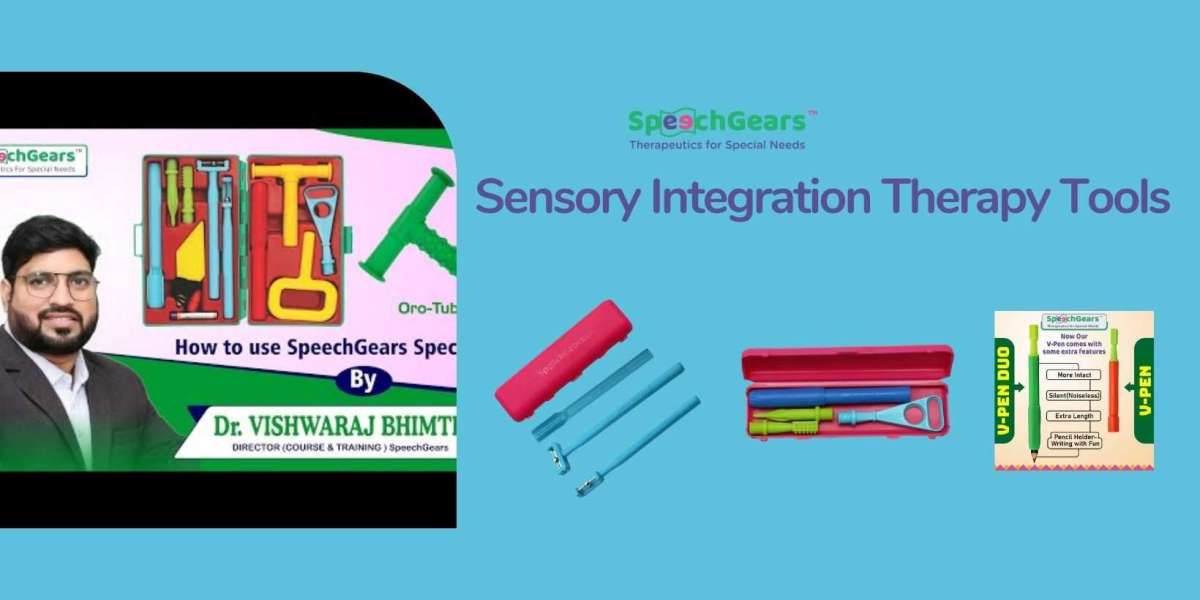Speech delays can significantly impact a child's ability to communicate effectively, leading to challenges in both academic and social settings. Often, speech delays are intertwined with sensory processing issues, making it crucial to address both aspects for effective treatment. Sensory integration therapy tools play a vital role in this comprehensive approach, supporting children in developing the sensory processing skills needed for successful speech and language development. In this blog, we'll explore the connection between sensory integration and speech delay, the importance of early intervention, and how the right tools can make a significant difference.
Understanding Speech Delay and Its Causes
Speech delay occurs when a child doesn't develop speech and language skills at the expected rate. Common symptoms include limited vocabulary, difficulty forming sentences, and trouble understanding language. Several factors can contribute to speech delay, including:
- Hearing Impairments: Hearing loss can hinder a child's ability to mimic and produce sounds.
- Developmental Disorders: Conditions such as Autism Spectrum Disorder (ASD) and intellectual disabilities often involve speech and language delays.
- Environmental Factors: Lack of verbal interaction and stimulation can lead to delayed speech development.
- Neurological Conditions: Brain injuries or conditions affecting neurological function can impact speech and language skills.
- Oral-Motor Problems: Physical issues with the mouth, tongue, or jaw can make speech production difficult.
The Link Between Sensory Processing and Speech Delay
Sensory processing refers to the way the brain organizes and interprets sensory information from the environment. Children with sensory processing issues may have difficulty responding appropriately to sensory inputs, which can affect their ability to focus, engage, and learn speech and language skills. For instance, a child who is overly sensitive to noise might find it hard to concentrate on speech sounds, while a child with proprioceptive issues may struggle with the motor control needed for articulation.
The Importance of Early Intervention
Early intervention is critical for children with speech delays and sensory processing issues. Addressing these challenges early can lead to significant improvements in communication skills and overall development. Speech therapy combined with sensory integration therapy provides a comprehensive approach that targets both speech and sensory processing issues.
Sensory Integration Therapy Tools
Sensory integration therapy tools are designed to help children process sensory information more effectively. These tools can be used in various activities to stimulate different senses, helping the brain to adapt and improve its processing abilities. Here are some essential sensory integration therapy tools that can support speech delay treatment:
- Tactile Tools
Tactile tools such as textured objects, sensory bins, and brushes help children become more comfortable with different textures and improve their tactile discrimination skills. For example, exploring a sensory bin filled with rice or sand can provide calming sensory input and enhance fine motor skills needed for speech production. - Proprioceptive Tools
Proprioceptive tools provide deep pressure input, which helps children become more aware of their body position and movement. Weighted blankets, compression garments, and body socks can calm an overactive nervous system, reduce anxiety, and improve focus during speech therapy sessions. - Vestibular Tools
Vestibular tools like swings, balance boards, and therapy balls stimulate the balance system. These tools help children improve their balance, coordination, and spatial orientation, which are crucial for speech articulation and overall motor planning. - Auditory Tools
Auditory tools, including noise-canceling headphones, musical instruments, and auditory processing games, help children manage their response to sound. These tools can improve auditory processing skills and make it easier for children to focus on and replicate speech sounds. - Visual Tools
Visual tools such as light boards, visual schedules, and color-coded materials help children with visual processing challenges. Clear and organized visual input can reduce anxiety and improve compliance with speech therapy activities.
Integrating Sensory Tools into Speech Therapy
Effectively integrating sensory integration therapy tools into speech therapy requires a tailored approach to meet each child's unique needs. Here are some strategies for incorporating these tools into therapy sessions:
- Assessment and Customization
Start with a thorough assessment of the child's sensory processing and speech abilities. This assessment will guide the selection of appropriate tools and activities, ensuring that the therapy plan addresses the child's specific challenges. - Creating a Sensory-Friendly Environment
Set up a sensory-friendly environment that includes a variety of sensory integration tools. This environment should be calm and inviting, allowing children to explore different sensory inputs at their own pace. - Incorporating Sensory Breaks
Sensory breaks during therapy sessions can help children stay regulated and focused. These breaks can include activities such as using a weighted blanket, bouncing on a therapy ball, or exploring a sensory bin. Sensory breaks can reset the nervous system and improve engagement. - Using Sensory Tools in Structured Activities
Integrate sensory tools into structured speech therapy activities. For example, use a swing to improve vestibular processing while practicing balance and coordination, or use textured objects to work on tactile discrimination during a fine motor activity. Combining sensory input with skill-building activities can enhance therapy effectiveness. - Monitoring Progress and Adjusting the Plan
Regularly monitor the child's progress and adjust the therapy plan as needed. Sensory integration is a dynamic process, and the child's needs may change over time. Adjusting the plan to incorporate new tools or activities can help maintain progress and address emerging challenges.
Benefits of Using Sensory Integration Therapy Tools in Speech Delay Treatment
Using sensory integration therapy tools as part of a comprehensive treatment plan offers numerous benefits:
- Improved Sensory Processing
Sensory tools help the brain learn to process sensory information more effectively, leading to better responses to sensory input and improved daily functioning. - Enhanced Motor Skills
Tools that target proprioceptive and vestibular processing can improve motor skills such as balance, coordination, and body awareness, which are crucial for speech articulation. - Better Emotional Regulation
Sensory integration therapy can help children manage their emotions more effectively, reducing anxiety and frustration that can interfere with speech development. - Increased Engagement and Participation
Sensory tools make therapy sessions more interactive and enjoyable, increasing the child's motivation to participate and practice new skills.
Conclusion
Sensory integration therapy tools are essential for helping children with speech delays and sensory processing disorders improve their communication and sensory processing abilities. By providing targeted sensory input through structured activities, these tools can make a significant difference in therapy outcomes. At SpeechGears, we offer a comprehensive range of sensory integration tools designed to support effective speech therapy. Visit SpeechGears to explore our therapeutic special kit and discover how our tools can enhance your therapy practice. With the right tools and strategies, children with speech delays can unlock their full potential and lead more fulfilling lives.








